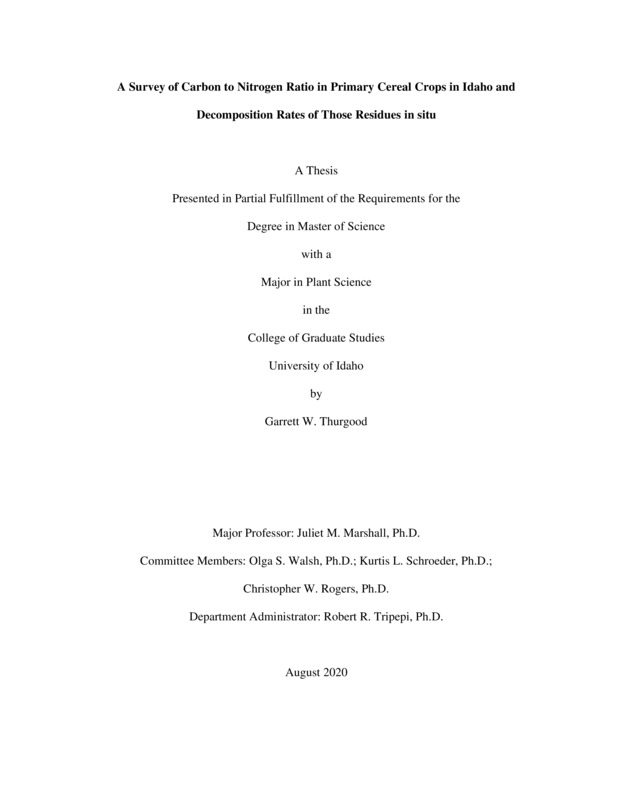A Survey of Carbon to Nitrogen Ratio in Primary Cereal Crops in Idaho and Decomposition Rates of Those Residues in situ
Thurgood, Garrett. (2020-08). A Survey of Carbon to Nitrogen Ratio in Primary Cereal Crops in Idaho and Decomposition Rates of Those Residues in situ. Theses and Dissertations Collection, University of Idaho Library Digital Collections. https://www.lib.uidaho.edu/digital/etd/items/thurgood_idaho_0089n_11907.html
- Title:
- A Survey of Carbon to Nitrogen Ratio in Primary Cereal Crops in Idaho and Decomposition Rates of Those Residues in situ
- Author:
- Thurgood, Garrett
- Date:
- 2020-08
- Program:
- Plant, Soil and Entomological Sciences
- Subject Category:
- Plant sciences
- Abstract:
-
Barley (Hordeum vulgare L.), corn (Zea mays L.), and wheat (Triticum aestivum L.) are commonly grown cereal crops throughout the state of Idaho. Residue management from these cereal crops should be considered to optimize residue-soil nutrient availability and improve factors which affect residue decomposition. High carbon to nitrogen (C:N) ratios and biomass accumulation for barley, corn, and wheat are commonly found post-harvest and effects from this are important for soil N availability in subsequent crops. The first study of this thesis sought to increase the understanding of the C:N ratios of barley and wheat. This was accomplished via a sample survey which was conducted throughout multiple locations with the objective to assess the C: N ratio of residue and biomass accumulation from various cultivars throughout Idaho. The results from this survey study showed high variability of C:N ratios between locations and no differences between cultivars. In contrast, biomass accumulation from the survey measured greater output from irrigated regions in general and differences were seen between locations and cultivars separately. The second study of this thesis focused on common practices for residue decomposition. Residue may be managed by placing the residue on the soil surface (no till) or by incorporation (tillage). Factors which may influence the rate of residue decomposition include residue source, C:N ratio, and cultural practices in the field (e.g., fertilizer nitrogen (N) additions). Therefore, a field study was set up with the objective to utilize residual cereal crop biomass and assess variation of in-field residue decomposition as affected by N fertilizer rates and residue placement (surface vs. incorporated) between fall and springtime. In general, the findings from the field study measured greater carbon and weight loss from incorporated treatments.
- Description:
- masters, M.S., Plant, Soil and Entomological Sciences -- University of Idaho - College of Graduate Studies, 2020-08
- Major Professor:
- Marshall, Juliet M
- Defense Date:
- 2020-08
- Identifier:
- Thurgood_idaho_0089N_11907
- Type:
- Text
- Format Original:
- Format:
- application/pdf
- Rights:
- In Copyright - Educational Use Permitted. For more information, please contact University of Idaho Library Special Collections and Archives Department at libspec@uidaho.edu.
- Standardized Rights:
- http://rightsstatements.org/vocab/InC-EDU/1.0/

